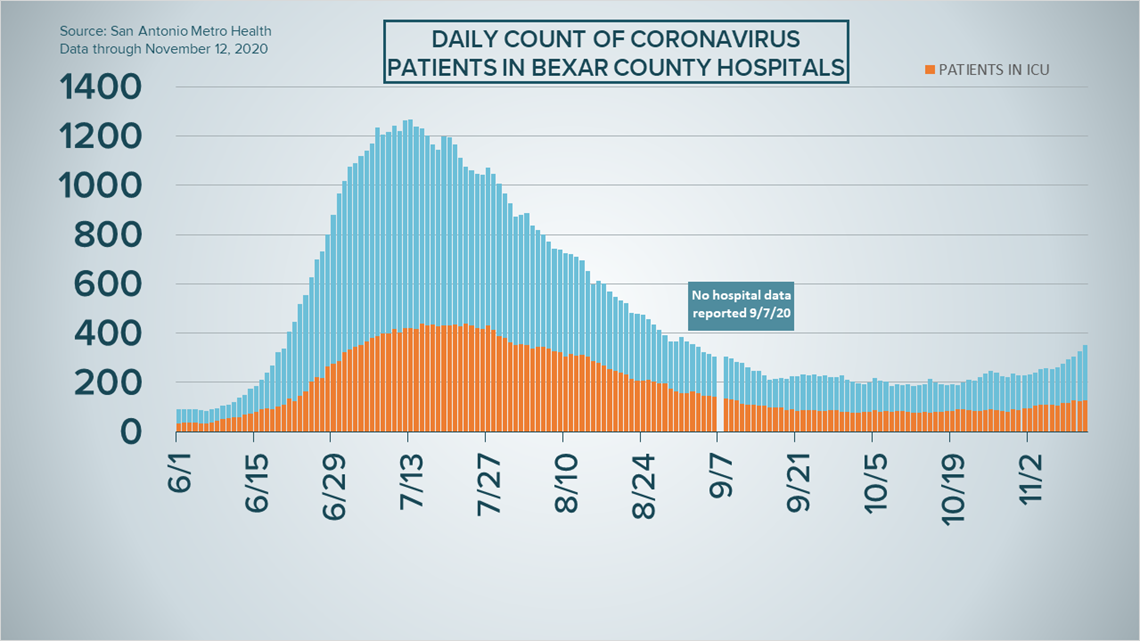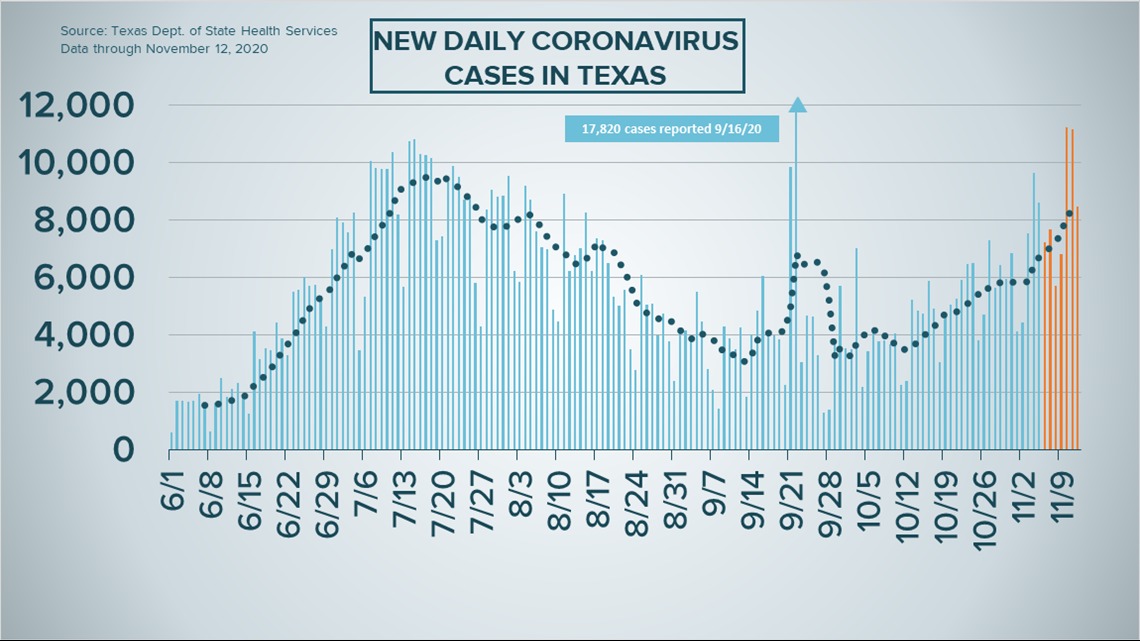SAN ANTONIO — We're tracking the latest numbers from the coronavirus pandemic in San Antonio and across Texas. Here are the latest numbers reported by Bexar and surrounding counties:
- Bexar County: 301 new cases were reported Thursday, bringing the total number of cases for the county to 69,014. Two new deaths were also reported, bringing the death toll to 1,287.
- Comal County: The county reported 11 new COVID-19 cases Thursday. One new virus-related death was reported. There have been a total of 4,008 reported cases of COVID-19 in the county – including 2,961 lab-confirmed cases – while 124 county residents have died. County officials say there are 223 active coronavirus cases, and 3,661 residents are considered recovered.
- Hays County: Officials in Hays County on Thursday reported 99 new cases in the county, covering the last two days after no new figures were released on Veterans Day, and no additional virus-related deaths. As of Thursday, there are a total of 6,585 lab-confirmed cases in the county (482 of which are active), while the death toll remained at 91. 6,012 residents have recovered from the virus. (No data was reported Wednesday)
How Bexar County is trending
We've tracked how many coronavirus cases have been confirmed in Bexar County from the time officials began reporting cases in March 2020. The graphic below shows the number of cases since June and charts those daily case numbers along a 7-day moving average to provide a more accurate picture of the overall coronavirus case curve in our area and the direction we're trending amid the pandemic.
Mayor Ron Nirenberg remained absent from Thursday's daily coronavirus briefing as he completes a precautionary two-week quarantine at home after a COVID-19 exposure scare; he tested negative on Tuesday.
In his place was Assistant City Manager Colleen Bridger, who reported an additional 301 coronavirus cases in Bexar County, bringing the total number of local infections to 69,014 since the pandemic began. While there was no briefing on Wednesday in observance of Veterans Day, Metro Health's online dashboards reflect that the daily total for Wednesday was 337 cases and no new deaths.


Meanwhile, the number of local COVID-19 patients in hospitalized rose by 47 since Tuesday, and stands at 353 on Thursday. That's the highest the number has been for Bexar County since Sept. 2, but Bridger noted that 61 of them are from the El Paso area, which has been overwhelmed by COVID-19 in recent weeks.
Of the 353 patients, 62 are on ventilators and 128 are in ICU.


Coronavirus in Texas
The total number of novel coronavirus cases in the state since the pandemic began grew by 5,726 on Thursday, according to the Texas Department of State Health Services. Another 2,705 were attributed to backlogs not yet added to the state's total. (More details can be found at the top of this page.)
As of Thursday, at least 1.031 million Texans have contracted COVID-19. This includes 993,841 cases confirmed positive by PCR molecular testing as well as 37,190 antigen-positive cases as reported by DSHS.


State health authorities also reported 143 additional virus-related deaths on Wednesday. At least 19,147 Texans have passed away from COVID-19 complications.
Meanwhile, the overall number of Texans hospitalized for COVID-19 on Thursday rose by 146, bringing the current total to near 7,000 for the first time since early August after Wednesday's drastic increase. A total of 6,925 Texas residents are currently receiving COVID-19 treatment in state hospitals.
Over the last week, the number of Texas hospitalizations have gone up by 16.3%, continuing a trend that began in early October that indicates a resurgent virus spread in the Lone Star State.
The state estimates that 838,950 Texans have recovered, while 138,137 Texans remain ill with COVID-19.
Meanwhile, the latest update from the Texas Education Agency showed that there have been 39,291 cumulative cases among staff and students across the state through Nov. 8. More information can be found here.
The TEA releases new data on school cases every Thursday.
Latest Coronavirus Headlines
- Not a numbers game: COVID-19 confirmations as big as Texas
- Ticketmaster says it won't require proof of COVID-19 vaccines, but event organizers might
- Blanco ISD shifts to remote learning as local coronavirus cases spike
- Post-election tension clouds chances for second stimulus check, COVID-19 relief
- Feds announce COVID-19 vaccine agreement with pharmacies, drug stores
- How an epidemiologist plans to host a safe holiday meal during coronavirus
- 709,000 seek US jobless aid as coronavirus pandemic escalates
- Fauci: Wear a mask, stay distant to avoid lockdown
- US reports most single-day COVID-19 deaths since May
- CDC study shows working in the office doubles coronavirus risk, compared to working at home
Coronavirus symptoms
The symptoms of coronavirus can be similar to the flu or a bad cold. Symptoms include fever or chills, cough, shortness of breath or difficulty breathing, fatigue, muscle or body aches, headache, new loss of taste or smell sore throat, congestion or runny nose, nausea or vomiting and diarrhea, according to the Centers for Disease Control.
Most healthy people will have mild symptoms. A study of more than 72,000 patients by the Centers for Disease Control in China showed 80 percent of the cases there were mild.
But infections can cause pneumonia, severe acute respiratory syndrome, kidney failure, and even death, according to the World Health Organization. Older people with underlying health conditions are most at risk.
But infections can cause pneumonia, severe acute respiratory syndrome, kidney failure, and even death, according to the World Health Organization. Older people with underlying health conditions are most at risk.
Experts determined there was consistent evidence these conditions increase a person's risk, regardless of age:
- Chronic kidney disease
- COPD (chronic obstructive pulmonary disease)
- Obesity (BMI of 30 or higher)
- Immunocompromised state (weakened immune system) from solid organ transplant
- Serious heart conditions, such as heart failure, coronary artery disease, or cardiomyopathies
- Sickle cell disease
- Type 2 diabetes
The CDC believes symptoms may appear anywhere from two to 14 days after being exposed.
Human coronaviruses are usually spread...
- Between people who are in close contact with one another (within about 6 feet).
- Through respiratory droplets produced when an infected person coughs, sneezes or talks. These droplets can land in the mouths or noses of people who are nearby or possibly be inhaled into the lungs.
- Some recent studies have suggested that COVID-19 may be spread by people who are not showing symptoms.
Help stop the spread of coronavirus
- Stay home when you are sick.
- Eat and sleep separately from your family members
- Use different utensils and dishes
- Cover your cough or sneeze with your arm, not your hand.
- If you use a tissue, throw it in the trash.

